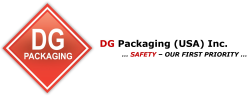

Dangerous Goods Classes
Dangerous goods (DG), also known as hazardous materials or hazmat, are categorized into different classes based on the type of hazard they present during transportation.
These classes, as defined by international regulations such as the United Nations Recommendations on the Transport of Dangerous Goods (UN Model Regulations), help to identify the nature of the hazards and guide proper handling, packaging, and transportation procedures.
The Class number of dangerous goods does not have any relationship to the severity or degree of danger posed by a product.
- Class 1: Explosives
- This class includes substances and articles that are capable of producing an explosion or releasing energy suddenly, such as fireworks, ammunition, and blasting agents.
- Class 2: Gases
- Gases are categorized as Class 2 dangerous goods and further divided into three divisions:
- Division 2.1: Flammable gases (e.g., propane, butane)
- Division 2.2: Non-flammable, non-toxic gases (e.g., nitrogen, carbon dioxide)
- Division 2.3: Toxic gases (e.g., chlorine, ammonia)
- Division 2.1: Flammable gases (e.g., propane, butane)
- Gases are categorized as Class 2 dangerous goods and further divided into three divisions:
- Class 3: Flammable Liquids
- Flammable liquids are liquids that have a flash point below 60°C (140°F) and can ignite and burn easily. Examples include gasoline, alcohol, and acetone.
- Class 4: Flammable Solids
- Flammable solids are solids that are readily combustible or may contribute to fires through friction. This class is divided into two divisions:
- Division 4.1: Flammable solids (e.g., matches, powdered metals)
- Division 4.2: Spontaneously combustible materials (e.g., phosphorus, aluminum alkyls)
- Flammable solids are solids that are readily combustible or may contribute to fires through friction. This class is divided into two divisions:
- Class 5: Oxidizing Substances and Organic Peroxides
- Oxidizing substances and organic peroxides are materials that can cause or contribute to the combustion of other materials. This class is divided into two divisions:
- Division 5.1: Oxidizing substances (e.g., hydrogen peroxide, potassium permanganate)
- Division 5.2: Organic peroxides (e.g., benzoyl peroxide, cumene hydroperoxide)
- Oxidizing substances and organic peroxides are materials that can cause or contribute to the combustion of other materials. This class is divided into two divisions:
- Class 6: Toxic and Infectious Substances
- Class 6 dangerous goods are substances that are toxic to humans or the environment. This class is divided into two divisions:
- Division 6.1: Toxic substances (e.g., pesticides, cyanides)
- Division 6.2: Infectious substances (e.g., medical waste, biological specimens)
- Class 6 dangerous goods are substances that are toxic to humans or the environment. This class is divided into two divisions:
- Class 7: Radioactive Materials
- Radioactive materials are substances that emit ionizing radiation. Examples include medical isotopes, uranium and plutonium.
- Class 8: Corrosive Substances
- Corrosive substances are materials that can cause severe damage to living tissue or other materials upon contact. Examples include sulfuric acid, sodium hydroxide, and battery acid.
- Class 9: Miscellaneous Dangerous Goods
- Class 9 includes substances and articles that present dangers during transportation but do not fit into any of the other classes. This category may include environmentally hazardous substances, elevated temperature materials, and miscellaneous articles and substances not otherwise classified. Lithium batteries are also included within Class 9
For all stakeholders engaged in the transportation of dangerous goods accurate classification ensures the safe handling, packaging, and transportation of hazardous substances, aligning with national and international regulatory standards.